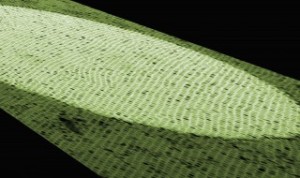Sep 16 2010
Two groups of scientists who rarely get together will jointly consider the technological future of nanoscale materials in a workshop that will meet at the University of Chicago’s Kersten Physics Teaching Center from Sept. 16-18.
The Electronic Transport in Nanoengineered Materials workshop is sponsored by UChicago’s Materials Research Science and Engineering Center. Among the approximately 70 participants will be physical chemists, who make new materials and study their properties, and theoretical physicists who specialize in the study of solid matter.
 The University of Chicago’s Materials Research Center will host a workshop on “Transport in Nanoengineered Materials” from Sept. 16 to 18. Topics will include the synthesis of materials at the nanoscale of atoms and molecules.
The University of Chicago’s Materials Research Center will host a workshop on “Transport in Nanoengineered Materials” from Sept. 16 to 18. Topics will include the synthesis of materials at the nanoscale of atoms and molecules.
“You don’t find this kind of assembly of high-powered, solid-state theorists and high-powered chemists together in the same room,” said Philippe Guyot-Sionnest, a Professor in Chemistry and Physics at UChicago.
Materials development over the last few years motivated Guyot-Sionnest and Dmitri Talapin, Assistant Professor in Physics, to organize the workshop, along with their UChicago colleagues Henrich Jaeger, the William J. Friedman and Alicia Townsend Professor in Physics, and Ilya Gruzberg, Assistant Professor in Chemistry.
“The theoretical background existed for about half a century,” Talapin said. “During the past five years or so, maybe 10 years at most, people learned how to make really amazing materials that theoreticians could not even dream about 20 years ago.”
Conventional methods for building smaller electronic components have involved working from the top down: chiseling ever-finer structures out of a larger piece of material. The workshop participants, by contrast, are focused on working from the bottom up: building larger structures from smaller building blocks.
Workshop participants will grapple with two challenges: is it now possible to synthesize three-dimensional materials at the nanoscale of atoms and molecules? And further, can the components of these objects communicate with each other via magnetic, thermal or electric signals?
Much of the workshop will highlight the technological potential of quantum dots, which are also called semiconductor nanocrystals. Quantum dots emit light in a rainbow of colors and have previously been used in lasers, biological studies and other applications.
Speakers focusing on quantum dots will include Moungi Bawendi, PhD’88, and Vladimir Bulovic, both of the Massachusetts Institute of Technology. Bawendi invented a method for making quantum dots that scientists have adopted the world over. He collaborates with Bulovic, who founded a start-up company, QD Vision of Watertown, Mass., to harness the capabilities of quantum dots for flat-panel displays and other products.
“He wants to make flat-panel displays that compete with the organic, light-emitting diode displays you see now starting to emerge from Samsung and other electronic companies,” Guyot-Sionnest said.
Structural disorder in nanocrystals
The structural disorder common to nanocrystals presents a hurdle for device makers, according to Guyot-Sionnest. “The question is, how do you get charge to flow smoothly through such an array of boulders,” he said.
Transporting electrons through quantum dots was not possible as recently as eight years ago. “It just then started to become conceivable that you could get electron flow, and there’s been constant progress,” Guyot-Sionnest said.
Also speaking at the workshop will be the University of Minnesota’s Boris Shklovskii, who helped pioneer the theory of electron transport through disordered materials in the 1970s.
“A peculiar thing about this field is that the theoretical framework used to describe this transport is really sophisticated,” Talapin said. Developing this framework led to the 1977 Nobel Prize in Physics for Sir Neville Mott and to the 1986 Landau Prize of the Soviet Academy of Sciences for Shklovskii.
The conference will close on Saturday afternoon with a session on superconductivity, the transmission of electric current without any loss of flow. Superconductivity can now be achieved only at freezing temperatures.
Superconductivity at higher, more practical temperatures has been touted for potential applications ranging from superfast computers to levitating trains. It remains unknown if nanoengineering can lead to a better superconductor, said Guyot-Sionnest, “but it is conceivable that controlling the nanoscale can positively affect the parameters controlling the critical temperature.”
Source: http://www.uchicago.edu/